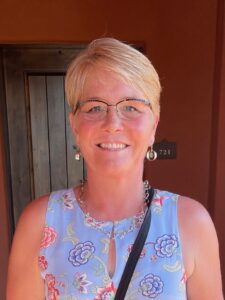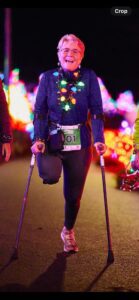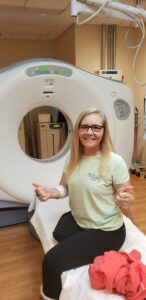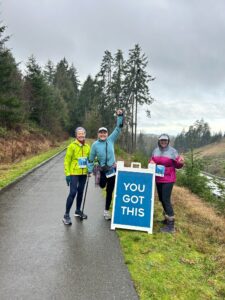
Rare Community Profiles is a Patient Worthy article series of long-form interviews featuring various stakeholders in the rare disease community, such as patients, their families, advocates, scientists, and more.
Amputation, Desmoid Tumor Recurrence, and Hope: How a Clinical Study Changed Dana’s Trajectory

In 1997, Dana, a marine biologist and current nonprofit expert, was living in the Florida Keys, relishing each day of sunshine and snorkeling. She was 24 years old and felt invincible. When she was enjoying her time in the sun and the sand, she was an avid runner, preparing for her first marathon.
The lump on the back of her calf wasn’t initially worrisome. A bit sore, perhaps. But Dana’s primary care physician shrugged it off, telling her it was a hematoma that would resolve on its own.
But something felt off. Dana wanted to pursue a second opinion, but living in a remote area made it hard to get referrals—and hard to navigate the system. It took two years before Dana knew that she couldn’t wait any longer. The lump had increased in size; her mobility suffered as she began losing function in the leg.
In 1999, after being transferred to the Sylvester Comprehensive Cancer Center in Miami, an MRI discovered that Dana had a desmoid tumor.
Desmoid tumors are rare, yet they can inflict profound challenges on those affected. While doctors presented a rosy picture of desmoid tumor treatment, the resulting years led Dana through a relentless battle that ultimately resulted in the difficult decision to amputate her leg. In 2013, after her desmoid tumor recurred after amputation, Dana jumped at the chance to participate in a clinical study which transformed the trajectory of her life.

In her interview with Patient Worthy, Dana discusses what desmoid tumors are, advancements in medical research and development, and the importance of advocacy.
What is a Desmoid Tumor?
Also known as desmoid fibromatosis or aggressive fibromatosis, desmoid tumors are rare and locally invasive soft tissue tumors. As the Desmoid Tumor Research Foundation (DTRF) explains, desmoid tumors form on connective tissue and can manifest anywhere throughout the body. More common sites of desmoid tumor appearance include the abdomen, head and neck area, and arms and legs.
Symptoms of a desmoid tumor vary based on where the tumor is located. Potential symptoms include impaired mobility, pain and inflammation, visible deformities, and pressure on nearby organs that may affect anything from breathing to bowel function. Other individuals may experience no symptoms.
Desmoid tumor behavior and recommended treatments can vary from case to case. In the latest NCCN Guidelines for Patients®, desmoid tumor experts no longer recommend surgery as the first option to treat most desmoid tumors since there is a high rate of recurrence following surgical resection. Other care options may be considered first based on the location of the tumor and other factors.
Unfortunately, members of the medical community do not entirely agree on how to classify desmoid tumors. Many physicians consider desmoid tumors to be locally invasive, but do not consider desmoid tumors to be cancerous (malignant) as they cannot metastasize (spread) through the blood or lymph systems. Because of this, the term “benign” is used by many doctors, which Dana strongly believes is incorrect and oversimplifies this disease by dismissing its nuances. It is strongly encouraged that patients with this non-metastasizing disease be treated by sarcoma (rare cancer) specialists.
To Dana, it is important to change the public perception of what a desmoid tumor is and show how aggressive, invasive, and devastating a desmoid tumor can be. One of the ways that Dana works to change the conversation around desmoid tumors is by using language like cancer and sarcoma when describing her experiences. She says:
“I use this language because that is the experience that I’ve had. I feel like I’ve had to fight for the right to use that terminology. Desmoid tumors are categorized as an intermediate type of sarcoma—not benign or malignant, but between the two, as the World Health Organization (WHO) indicates.”
The Mental Health Impact
In the years since her diagnosis, Dana has dealt with innumerable recurrences; she has also tried many different treatment interventions. However, as she stated before, the public perception and classification of desmoid tumors makes it more difficult for those affected to access treatment. Says Dana:
“Today there is an FDA-approved treatment for desmoid tumors, but when I was diagnosed, I received chemotherapy and radiation. Others diagnosed at that time may have required other interventions like cryoablation, surgery or, even in cases like mine, eventual amputation. But many of these treatments were denied because of how insurance works. Historically, we were unable to access treatment because of the red tape and the lack of a proper classification for desmoid tumors. We still face major issues with the way desmoid tumors are incorrectly classified as benign, which minimizes their effect on our lives and impacts our ability to access certain type of treatments. My desmoid tumor left me unable to work and despite purchasing supplemental disability and going to the same hospitals and getting the same treatments as malignant cancer patients, getting access to the treatments I needed was very difficult for me.”
Dana says that people with desmoid tumors often experience medical gaslighting, not just from physicians but from friends and family. She shares:
“Family and friends hear this rhetoric that a desmoid tumor is ‘just a benign tumor’ and that ‘at least it isn’t cancer.’ So they repeat this back to us when we go to them for support, even with experiences that are far different from that rosy view. My doctors told me we would remove the tumor and be done, but I had recurrences within six months. This toxic positivity of ‘oh, it isn’t cancer’ takes our lived experiences and minimizes it by comparing it to something else that could be far worse, and that doesn’t validate what people with desmoid tumors are actually dealing with. Your support system breaks down, which furthers the sense of isolation.”
To Dana, these are the higher-level aspects of managing a rare condition that really play into mental health challenges. People with desmoid tumors are repeatedly told that the experience they are having is not actually the experience that they’re living:
“It diminishes you and makes you feel crazy. Am I not able to tolerate this? Why is this so difficult? Why will nobody listen? I’m a big believer that there is a holistic relationship between body and mind. The worse your mental health, the less chance you have to heal. And for people with desmoid tumors, it’s hard to heal when nobody is throwing us a lifeline.”
Amputation: A Challenging Decision
After her initial surgery, Dana believed that she would be left with nothing more than a scar and a cool story. But years passed and it felt sometimes like she was fighting a losing battle. She tried every treatment, engaged in research to find new insights, and remained as strong of a self-advocate as possible while her tumor recurred, recurred, and recurred again.
“It is highly recommended that every desmoid tumor patient seek treatment by a sarcoma specialist who understands the complexities of this disease. Experienced teams know that, depending on the case, recurrence may come with surgery.”
– Lynne Hernandez, Exec Dir, The Desmoid Tumor Research Foundation
The tumor continued to grow to the point that it burst through the skin on her calf. For five years, Dana lived with an open wound. She often found herself in the hospital fighting system infections and had to get a PICC line placed. After nine years, Dana was tired. Suddenly, she shared:
“The balance of the scale tipped. I stopped worrying about my leg and started thinking about how to save my life. I saw my medical team and they told me it wasn’t a matter of if I had to amputate, but when. My mom was hoping that I would get a miracle. I told her, ‘Maybe this is my miracle.’”
In May 2008, Dana made the decision to amputate her leg. She called the surgery her Liberation Surgery: a way to get back to living rather than just surviving. On the day of her surgery, she showed up with tons of dry ice. She says:
“With the help of the Desmoid Tumor Research Foundation, I had connected with doctors at three hospitals who wanted my tissue for research. I made a deal with my surgeon that he would take care of it if I brought the dry ice. When I showed up, everyone was blown away.”

After the surgery, Dana finally felt like she was home-free. Recovery was strenuous but she persevered. Determined to get back into marathon running, she began learning how to use a prosthesis and a running blade. She was even running 5Ks.
In 2013, while training, Dana’s mobility began to decline again. She went to the doctor, thinking that she just pushed herself a little too far. But an MRI found that a new tumor had formed in her hip and pelvis. Says Dana:
“I thought amputating my leg would be the answer. Doctors told me I had an 80% chance of non-recurrence. I couldn’t believe it.”
The Nirogacestat Clinical Study
Dana was blown away when learning about the recurrence—and she realized that there was not nothing left in the way of traditional treatments. So, she jumped at the chance to join a Phase 2 clinical trial for an investigational drug called nirogacestat. She shared:
“The trial opened a month after I learned about my recurrence. I was patient number two. To me, I saw this as divine intervention. What better way to serve my community than to use my body to further this research and revolutionize treatment for this disease?”
Dana says that within three weeks of taking the treatment, nirogacestat significantly reduced her desmoid tumor size. She stayed on the treatment for four years and is now excited by the potential of having access outside of a trial setting. Nirogacestat, or now marketed by SpringWorks Therapeutics under the brand name Ogsiveo, became FDA-approved in November 2023. Lynne Hernandez, the Executive Director of the Desmoid Tumor Research Foundation, shared:
“The FDA approval of Ogsiveo represented a groundbreaking milestone for DTRF and everyone else facing—and working with—desmoid tumors. This is a watershed moment which will spark even more discovery, awareness, and dedication as we all continue working to uncover additional answers for patients.”
Becoming an Advocate
In many ways, Dana has been involved in advocacy since she was younger. As a survivor of domestic violence, Dana’s advocacy led her to become a certified credential victim advocate and to work with other survivors through Unbounded Horizons, which she founded in 2007.
In 2017, as she grappled with complex PTSD (CPTSD), the spark of her next advocacy work was set into motion. Dana found herself having difficulty concentrating, working, or feeling good about herself. Then she attended a retreat with other women who also had desmoid tumors. She shares:
“That was a pivotal and very cathartic moment for me. It was a safe space where we could come together, be validated, and have that shared experience. From there, I knew I could start climbing back out of the pit I felt I was in with another perspective. I started giving myself permission to call my desmoid tumor what it is.”
In September 2023, Dana and three other patients founded The Desmoid Project, a nonprofit organization dedicated to enhancing the quality of life for desmoid tumor patients, their families, and caregivers through comprehensive support and advocacy. The Desmoid Project is planning on launching a support group series for patients and resources on advocacy later this year. Says Dana:
“Right now, I am the proud mom of two cats, an avid outdoorswoman who loves hiking and marathons and does it all on my forearm crutches, and a frequent backpacker. But more than anything else, being disabled in a very able-bodied world has pushed me to be an advocate. At the end of the day, service is what fills my soul cup.”

For the people who are at the start of their desmoid tumor journey, Dana wants them to know that they, too, will one day become advocates. That they are not alone, and that it’s okay if right now, they just get through the day to day. While she and the Desmoid Project are ready to support anybody who needs it, she also reminds everyone:
“Have grace and compassion and patience for yourself as you go through this process. And remember – life is a marathon, not a sprint.”






